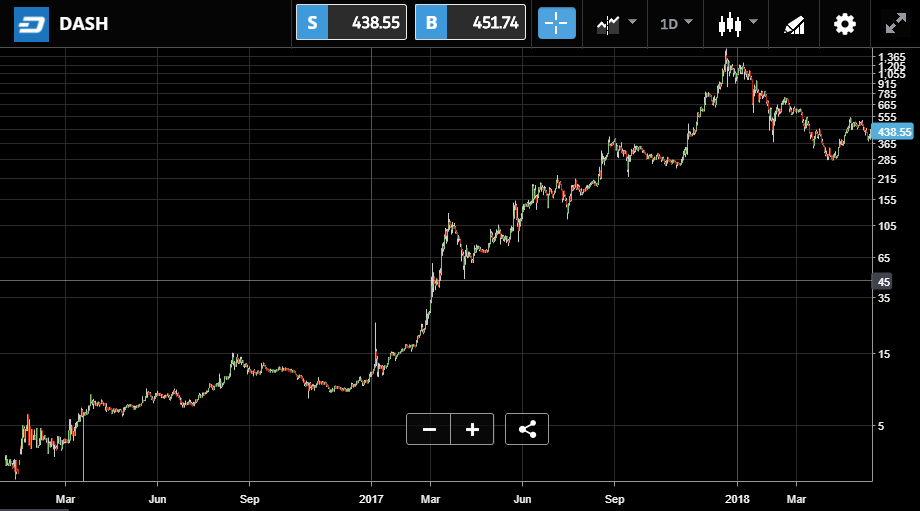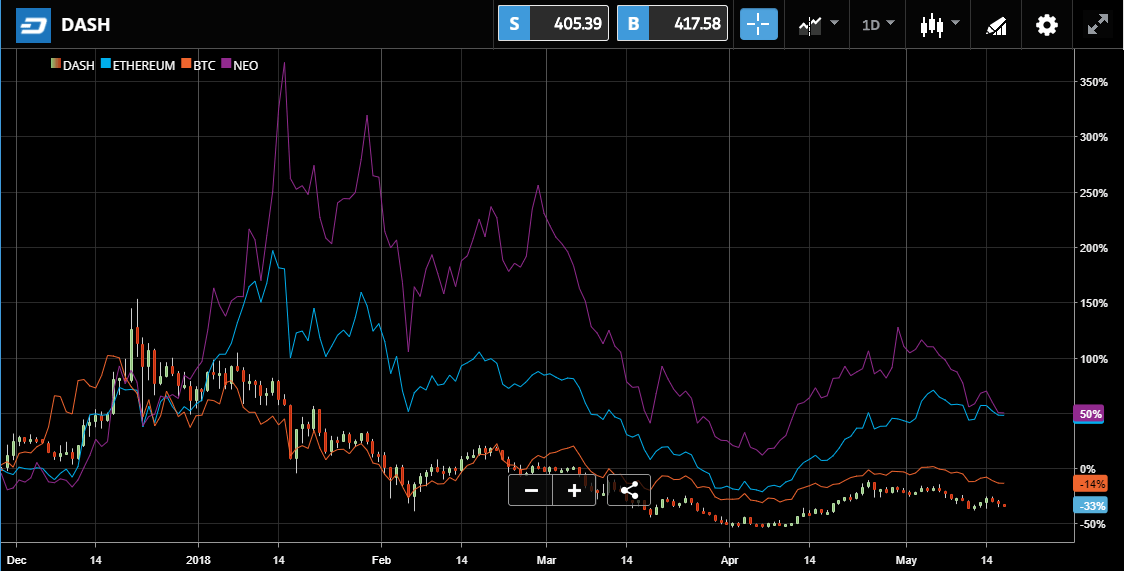Summary
Dash, is short for “Digital Cash”, and it aims to become exactly that. A pioneer in the crypto industry, Dash’s protocol is modeled after Satoshi’s original blockchain and adds a few unique features for maximum speed, privacy, and lower transaction fees. Thanks to these innovations, Dash has the potential to become a true standard for transactions between individuals in a decentralized and secure manner.
Not only is this one of the most well established cryptos in the payments space, but the community continues to innovate and bring crypto to new and exciting places, particularly in emerging markets. In addition, according to our findings below, we feel that this cryptocurrency is acutely undervalued compared to the rest of the cryptomarket.
Basic Stats
- Crypto-asset type: Money Coin
- Max supply: 18,900,000 DASH
- Circulating supply: 8,053,497 DASH
- Market Capitalization: $3.9 bn
- Inflationary cryptocurrency
- Like Bitcoin, creation of new Dash decreases by 7.1% approximately every year reaching an asymptotic value, thus making it effectively deflationary, until max supply is reached.
- Protocol: Proof of Work/Proof of Service
History
Dash, which stands for “Digital Cash”, was released in January 2014, based on the Bitcoin protocol and originally under the name XCoin. Founder Evan Duffield, having come across Bitcoin in 2010, wanted to introduce anonymity in the Bitcoin protocol. As that was impossible without a consensus among all developers of the blockchain, he decided to create his own cryptocurrency.
Soon after its creation, XCoin was renamed Darkcoin, highlighting its anonymity features. Finally, in March 2015, and trying to access a more mainstream market and establish itself as a standard for online payments, it was rebranded to its current ticker Dash.
Since 2014 and for several years, Dash has traditionally been among the five most highly valued cryptocurrencies in terms of total market capitalization, and surged incredibly in value along with the rest of the crypto sphere during 2017. Despite the emergence of new competition, Dash stands out as one of the most established cryptos in the industry.
Development Team
Evan Duffield created Dash in 2014 after seeing what he thought were inherent problems with the Bitcoin protocol. In 2017, Evan left his active role in Dash and was replaced by Ryan Taylor. They are arguably the two most recognizable faces of the Dash team.

|
Evan Duffield is the founder of Dash and was CEO of the project until April 2017. He started developing software at the age of 15 and worked in several public relations and financial companies before deciding to embark on creating the Dash protocol. After leaving the CEO position, he has remained in an advisory role in the Dash board and has focused on supporting further development of decentralized applications. |
| Ryan Taylor is the current CEO of Dash Core, which leads the development of the Dash project. Before joining Dash, he was an Associate Partner at McKinsey and also served as analyst in a New York-based multi-billion dollar hedge fund. He joined the project in 2014 and served as Dash’s Director of Finance before replacing Evan Duffield as CEO. |
|
Use Cases
Like Bitcoin, the main use case for which Dash was conceived was to enable secure, fast and affordable transactions between individuals all over the world without the need of a bank or any other centralized entity.
Going back to the definition of “money” in the 19th century, the main functions of money are to act as a medium of exchange, unit of account, and store of value.
Bitcoin has traditionally been used significantly more as a store of value than as a medium of exchange, hence acting more as a sort of “digital gold” than “digital money”. Arguably the main reasons for that are the relatively slow and expensive transactions.
Dash on the other hand, provides instant transactions with negligible fees, and so aims to become an actual form of digital cash that can be employed in online transactions, e-commerce, and even traditional establishments.
Dash is indeed being used by many as a store of value. In fact, holding Dash long term has additional incentives as well due to the the existence of something called masternodes. With this system, token holders with a large purchasing power are encouraged to hold 1,000 DASH (currently valued at approximately $500,000) in order to receive block rewards in the form of new coins for providing a series of services.
Dash already has significant adoption in several verticals, like in developing countries where cryptocurrencies are needed most Besides, there are thousands of merchants and hundreds of ATMs supporting Dash all over the world. In any case, and although its main use is still as a medium of exchange and store of value, Dash definitely has the potential to go beyond that, as will be shown in the following sections with the different projects that are being developed in the Dash environment.
Technical Description
Dash is indeed based on the Bitcoin protocol and is therefore intended to work purely as a digital currency, or money token, although with a new iteration called Evolution (which will be further described later), Dash will introduce Decentralized Application Protocols (DAPs) and data contracts.When compared to Bitcoin, Dash introduces a series of new features to make it more private, faster and more scalable.
Flagging that these references, whilst useful, will raise eyebrows and for some will act as a confirmation of negative suspicions!
What do you suggest?
Any other verticals or countries we can mention?
Perhaps the most important difference is the introduction of masternodes. Unlike Bitcoin, where miners are responsible for all services in the network, Dash uses a two-tier approach consisting of both miners and masternodes.
| In the Proof-of-Work protocol, computers in the network compete to solve mathematical problems in order to obtain rewards in the form of coins, while securing the network. A downside of this is the high costs and environmental impact in terms of energy associated with this protocol.
Meanwhile, in the Proof-of-Stake protocol, token holders are the ones in charge of validating transactions and securing the network, by staking (locking up) their coins temporarily in exchange of a reward similar to an interest payment. Many people believe this new protocol will become the new standard for cryptocurrencies. |
In the Dash system, miners still compete to find new blocks and obtain rewards. However, there is a second layer that introduces further features and that is formed by masternodes. Masternodes are nodes in the network that hold at least 1,000 DASH and are responsible for securing PrivateSend, InstantSend (which will be explored below) and other special features of the Dash protocol.
Because running a masternode has associated bandwidth and hardware requirements, masternode holders are also incentivized with block rewards. For every new block that is created, miners and masternodes receive 45% of the reward each, and the remaining 10% is assigned to a so-called “treasury” that is used to fund projects and contractors. Proposals to improve the network or add new features can be voted and funded with this budget.
Two important features of Dash mentioned above are PrivateSend and InstantSend. The former was the original differentiation factor with respect to Bitcoin, natively introducing privacy in the blockchain. PrivateSend (formerly known as DarkSend) is an improvement of CoinJoin, where transactions between users of the network are basically mixed together in order to make it virtually impossible to track them down. Unlike in the original CoinJoin protocol, where a centralized system is responsible of performing the mixing, in the case of Dash masternodes are responsible for this task, thus making the system decentralized and not dependent on a single entity. Private, non-trackable transactions are a very important feature of Dash, and have the goal of eliminating the transaction history of single coins and therefore making the currency fungible, that is, ensuring all coins are worth the same value.
On the other hand, InstantSend (formerly called InstantX), uses the masternode layer to introduce instant irreversible transactions. Once a transaction is submitted to the network, masternodes quickly confirm it and ensure those coins cannot be spent again (duplicated). This can allow, still in a decentralized and secure way, to have instant payments in daily commerce using Dash in a similar way to how traditional cash is used with debit or credit cards.
Future Developments
One of Dash’s most exciting upcoming projects is Dash Evolution. Dash Evolution leverages Dash’s multi-layer architecture to securely and scalably enable developers to build trustless applications secured by the blockchain. These client-executed applications interact with the consensus validated data they have stored on DashDrive via the Decentralized API (DAPI). Besides, it will introduce blockchain-based usernames that allow Evolution applications to handle secure authentication while also providing a user-friendly alternative to the complicated addresses frequently associated with cryptocurrency interactions.
A new marketplace will introduce an approachable exchange for sellers and buyers, and will enable one-click payments for websites, stores and applications. This user-friendly system should behave similar to a mobile app store, greatly improving the utility of the coin for its average users.
With these advancements, Dash aims to become a sort of crossover between Facebook and Paypal, still with the advantages and security of a decentralized system.
Dash DAO & Projects
A Decentralized Autonomous Organization (DAO) is an organization of people that communicate with each other and take decisions on a network protocol, without the need of a centralized party. All DAOs are based on a monetary incentive, and Dash is no exception. The block reward obtained by miners and masternodes represents this monetary incentive.
10% of all block rewards are reserved for the Dash treasury. This is an important particularity of the Dash DAO because it allows the network to be completely self-sustainable. Developers, auditors, marketers, etc. can be contracted with these funds, which can also be used for supporting projects based on the Dash ecosystem. Masternodes, who are people with a substantial investment in the network and therefore a great stake on its success, are the ones that vote on the contractors and initiatives that receive money from the treasury. some of the most interesting Dash-based projects that have been supported by the treasury are:
- KuvaCash is a project to create an advanced mobile wallet powered by Dash, with the possibility of using or sending cash instantly anywhere in the world. Together with Dash, KuvaCash launched a program to fight hyperinflation in Zimbabwe and provide them with a stable currency.
- Similarly, Dash Venezuela aims to drive further adoption in Latin America, where they have reached hundreds of companies that are already accepting Dash for purchasing their products.
- Cryptocurrencies will likely first reach mainstream adoption in economies with a high inflation and decaying economy, where a strong and liquid currency is not readily available.
- Alt Thirty Six is a Dash Treasury-funded company that integrates thousands of cannabis merchants with patients and customers, and has a 3-year exclusive deal with Dash. The legal cannabis industry is set to grow from $17 billion in 2017 to $40 billion by 2021, and Alt Thirty Six has secured deals with some of the most important dispensary chains throughout the US, with the prestigious Palm Beach Research Group nicknaming it the “PayPal of the Pot Industry”. This is particularly important for an industry that has traditionally been linked to cash payments and where banking solutions are limited.
- FanDuel is one of the most important fantasy sports services in the US. During the last NBA playoffs, they partnered with Dash to offer fantasy sport competitions with Dash Initiatives like these will drive further the use of Dash and cryptocurrencies as a whole.
Token Valuation Analysis
The two main use cases of Dash, like any other currency, will be as a medium of exchange and as a store of value. These will also be the applications that will give value to the network.
The equation of exchange can be used to estimate the actual valuation of a crypto asset when considering its use as a means of exchange. This equation is as follows:
MV = PQ
where:
- M is the total supply of the cryptocurrency.
- V is the velocity of money, which measures how many times a unit of the currency is used in a certain period.
- P and Q are the price and quantity of the digital service or resource, and can be thought of as the transaction volume of the blockchain (the economic value transacted in a certain period).
An important aspect of this equation is that it considers the total supply M to be stable, something that is generally not true for cryptocurrencies and is definitely not for Dash, which has a decaying but significant inflation rate each year. Humans will naturally value less a currency whose supply increases every year versus one with stable supply. A solution to this is to add the discounted future supply to the current supply. Please see for a detail overview of the discount supply equations for a general case and for the particular case of a currency with decreasing inflation rate that tends to a fixed total supply in the future, like Dash is. The results will vary depending on the value that the users or holders give to future prices with respect to current ones. If they only care about the future value, the total supply should be used. On the other hand, if only the current value is relevant, the current circulating supply should be used. Here, for simplicity and also to account for the number of coins held by masternodes, M will be made equal to the current circulating supply of approximately 8 million Dash.
A current estimate for daily transaction volume in the Dash network shows an average of approximately 150,000 Dash, or $63 million, which yields a yearly volume of $23 billion ().
The velocity of money, which measures how many times on average a specific unit of the currency is transacted over a year, is a very difficult parameter to estimate. A possibility is to use the transaction volume and total supply of the currency to provide an estimation:

However, this estimation depends greatly on the evolution of the network and cannot be taken as granted. For reference, the velocity of money has a value of around 1.5 for Bitcoin. The value for Dash should indeed be significantly higher, given that transactions are much cheaper and faster, and Bitcoin is transitioning towards use as a store of value. Rather than go with the high velocity of 5.7 noted above, we felt it appropriate to be be conservative with our estimations and so will use a value of 4 in the equation of exchange. This leads to a market capitalization for Dash of $5.75 billion, which is approximately 73% higher than the current market cap of $3.31 billion.
Thus, according to this approximation, Dash would be incredibly undervalued.
| For more information regarding cryptoasset valuation models like the one used in this Section, please visit the following resources:
|
Investments Risks
Trading cryptocurrencies can potentially be very profitable as seen in the past, but it is also a very challenging activity that can carry a significant level of risk. Cryptocurrency markets are associated with high volatility, and Dash is no exception.
Although Dash has a clear, straightforward use case and has been operational for years, the environment of cryptocurrencies for online payments is extremely competitive and also has many of the world’s most powerful financial institutions as competitors. The future performance of Dash will of course depend on what fraction of the digital payment market it can gather.It is important to carefully assess your investment goals, methodology and level of experience before deciding to start investing in a new market. It is also extremely important to diversify and view cryptocurrency as an additional element of your portfolio. Given the high risk associated with this type of asset, it is recommended never to allocate more than 20% of your portfolio into cryptocurrencies. For risk averse investors the percentage should be significantly lower. Given that the possibility to lose a part or even all the money invested exists, it is extremely important to invest only money that you can afford to lose.
In any case, all the information presented in this Market Report does not constitute financial advice, and introduces no obligation or recommendations for action.
Technical Analysis

Exhibit 1: Historical Evolution of DASH/USD price since January 2016. Note that the scale is logarithmic.
Exhibit 1 shows the historical evolution of the DASH/USD price from January 2016 (trading at $3) until May 2018 (currently sitting just below $440). Please note, that we’ve used a log-scale graph, which is very popular for showing relative percentage movements. The price of Dash has indeed risen dramatically these last two years in parallel to the increasing valuation and use of all cryptocurrencies, reaching an all-time high value of $1500 in December 2017.
Since then, Dash has seen a severe correction of more than 70%.
Like the vast majority of cryptocurrencies, Dash is strongly dependent on the price evolution of Bitcoin, and has also shown some correlation with other currencies like ZCash and Ripple. However, the aforementioned correction of more than 70% during the bear market that started in January is significantly higher than the average of the market, with Dash underperforming Bitcoin, Ethereum and most other main cryptocurrencies, as can be seen on Exhibit 2.
Exhibit 2 shows the evolution of the DASH/USD price during this bear market. With the exception of a few rebounds, it followed a clear downtrend until the beginning of April, where it formed a double bottom support at $280. During April, it climbed back to $500 and has since remained relatively stable around the resistance established in February 2018 at $400. The medium-term trend of the price will depend on whether Dash is able to secure this support, as well as the result of testing higher resistances at the $600-700 levels.

Exhibit 2: Evolution of DASH/USD price since December 2017, compared to other cryptocurrencies (Neo, Bitcoin and Ethereum). Evolution is presented as % of the value as of December 1st.
Resources
Credits
- Yoni Assia – Founder and CEO of eToro, a leader in the blockchain community for kickstarting this in-depth analysis project.
- Orit Mutznik – For her support.
- – For their research and writing.
- Paz Diamant – Head of Blockchain development at eToro.
- Special thanks to from .
Disclaimer
Cryptocurrencies can fluctuate widely in prices and are therefore not appropriate for all investors. Trading cryptocurrencies is not supervised by any EU regulatory framework. The content is intended for educational purposes only and should not be considered as an investment advice. Your capital is at risk.
Contact Us
eToroX Crypto Exchange:
Corporate Accounts:
Affiliate Marketing:
Public Relations:
Customer Support:
eToro By Regions
Iqbal Gandham | UK Managing Director | Iqbal.v.
Jasper Lee | South East Asia Managing Director |
Guy Hirsch | United States Managing Director |
George Verbitsky | Russia & CIS Managing Director |
Robert Francis | Australia Managing Director |
Elie Edry | French & LatAm Regional Manager |
Emanuela Manor | Italian Regional Manager |
Dennis Austinat | Germany Regional Manager |
George Naddar | Arabic Regional Manager |
Yael Moscovitch | ROW Regional Manager |
Disclaimer: The opinions expressed in this article do not represent the views of NewsBTC or any of its team members. NewsBTC is neither responsible nor liable for the accuracy of any of the information supplied in Sponsored Stories/Press Releases such as this one.













